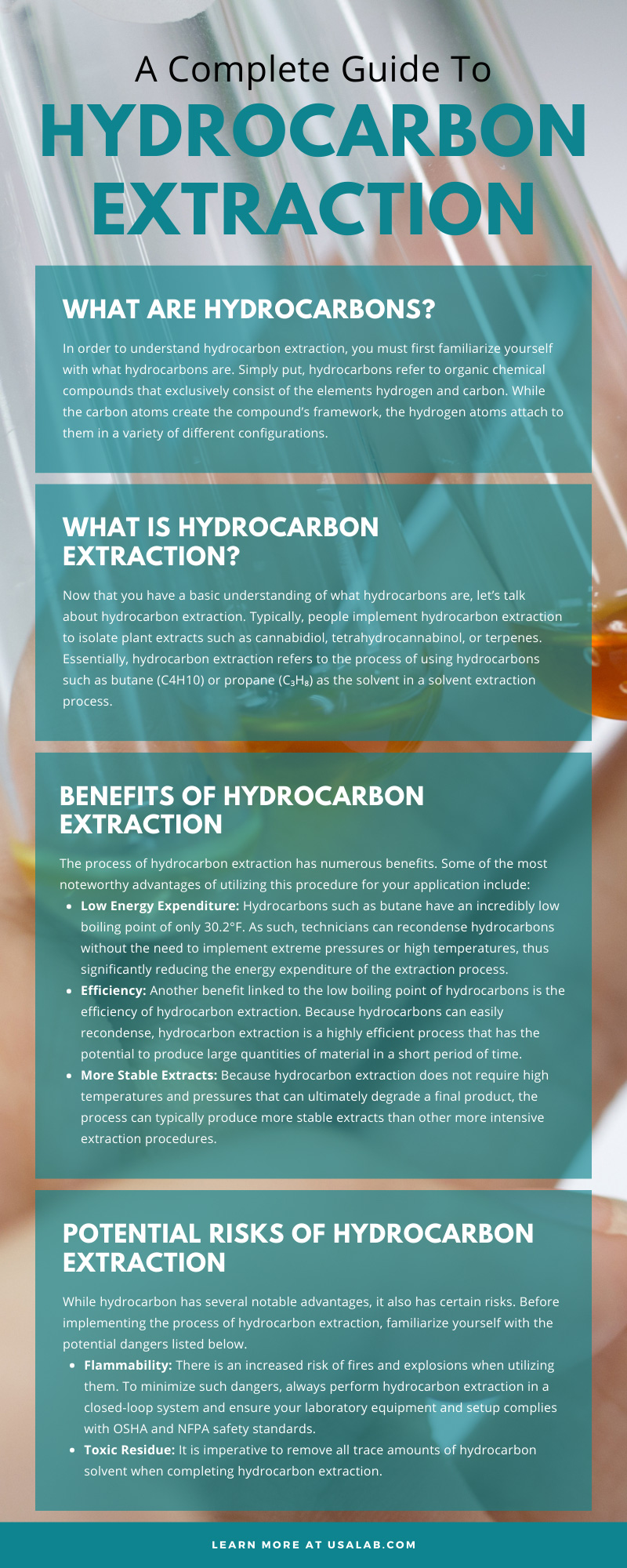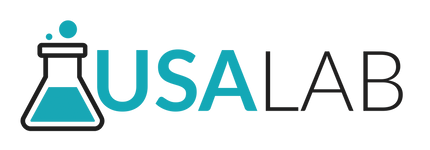What is Hydrocarbon Extraction | Extraction of Hydrocarbons
Posted by USA Lab Equipment on May 12th 2021
Extraction of hydrocarbons is a widely used extraction method often implemented to produce plant extracts such as CBD or terpenes. From its high degree of efficiency to its ability to create more stable products, this process provides numerous advantages over other extraction procedures. To determine if this process is the right choice for your application, consult this complete guide to hydrocarbon extraction.
What Are Hydrocarbons?
In order to understand hydrocarbon extraction, you must first familiarize yourself with what hydrocarbons are. Simply put, hydrocarbons refer to organic chemical compounds that exclusively consist of the elements hydrogen and carbon. While the carbon atoms create the compound’s framework, the hydrogen atoms attach to them in a variety of different configurations.
Often, hydrocarbons occur naturally in plants, trees, and fossil fuels. Such compounds serve as the primary components of petroleum and natural gas and can be utilized in a wide range of different applications, such as fuels, the production of plastics, and the process of hydrocarbon extraction.
What Is Hydrocarbon Extraction?
Now that you have a basic understanding of what hydrocarbons are, let’s talk about hydrocarbon extraction. Typically, people implement hydrocarbon extraction to isolate plant extracts such as cannabidiol, tetrahydrocannabinol, or terpenes. Essentially, hydrocarbon extraction refers to the process of using hydrocarbons such as butane (C4H10) or propane (C₃H₈) as the solvent in a solvent extraction process.
In solvent extraction, a substance that dissolves into a solvent is used to separate a compound from the rest of a plant or other material. This process takes place in a closed-loop extraction system that’s completely devoid of atmosphere to ensure the person conducting the process can recover and reuse the solvent to decrease waste.
Keep in mind that not all hydrocarbons serve as effectual solvents. The effectiveness of a hydrocarbon will largely depend on the chemical and structural properties of the hydrocarbon.
The Process of Hydrocarbon Extraction
Below, we will address some of the main stages of the hydrocarbon extraction process.
Acquire High-Quality Plant Material
Hydrocarbon extraction begins by acquiring the plant matter that you wish to derive an extract from. The quality of the extract will depend largely on the quality of the parent material, so it is essential to acquire high-grade plant matter and store it in an environment devoid of light or changing temperatures that can facilitate degradation.
Washing the Plant Material
Once you have acquired high-quality plant material, you can then begin the extraction process. To do so, start by flushing your chosen hydrocarbon (typically butane) through the solvent tank and into the pressurized main chamber of a multi-chamber extractor. Upon arriving in the main chamber, the hydrocarbon solvent will wash over the plant material and begin dissolving the desired extract, which may be cannabidiol, tetrahydrocannabinol, or terpenes. This process is commonly referred to as “washing.”
After the washing process, you can either collect the solution directly or process it further using a variety of different methods, such as in-line dewaxing or winterization. The choice of whether to continue refining the solution will depend on the desired purity and composition of your end product. While such processes can help filter out lipids and waxes, keep in mind that they could decrease the flavor of the resulting product and will increase the time the extraction takes to complete.
Collecting the Solution
After washing and potentially refining the solution further, it will enter the collection pot. Here, the vessel will heat up to passively push any residual hydrocarbon solvent back into the solvent tank, which is kept at a lower temperature. Once the hydrocarbon returns to the solvent tank, the closed-loop process is complete. To achieve your desired level of purity, this process may continue to repeat until the majority of the hydrocarbon solvent has been removed from the solution. Then, the concentrated solution will be collected for additional separation.
Implementing Further Separation Processes
Once the closed-loop extraction process has been completed, traces of the hydrocarbon solvent may still remain in the solution. If the hydrocarbons aren’t completely eliminated, they can leave behind toxic residue that decreases the quality and safety of the final product. As such, it is essential to remove any residual hydrocarbon solvent from your solution.
To do so, you can implement a variety of different purge methods depending on your desired final product. For example, you may implement extended whipping, place the solution in a vacuum, or utilize additional solvents such as ethanol to remove all residual hydrocarbon.
Benefits of Hydrocarbon Extraction
The process of hydrocarbon extraction has numerous benefits. Some of the most noteworthy advantages of utilizing this procedure for your application include:
- Low Energy Expenditure: Hydrocarbons such as butane have an incredibly low boiling point of only 30.2°F. As such, technicians can recondense hydrocarbons without the need to implement extreme pressures or high temperatures, thus significantly reducing the energy expenditure of the extraction process.
- Efficiency: Another benefit linked to the low boiling point of hydrocarbons is the efficiency of hydrocarbon extraction. Because hydrocarbons can easily recondense, hydrocarbon extraction is a highly efficient process that has the potential to produce large quantities of material in a short period of time.
- More Stable Extracts: Because hydrocarbon extraction does not require high temperatures and pressures that can ultimately degrade a final product, the process can typically produce more stable extracts than other more intensive extraction procedures.
Potential Risks of Hydrocarbon Extraction
While hydrocarbon has several notable advantages, it also has certain risks. Before implementing the process of hydrocarbon extraction, familiarize yourself with the potential dangers listed below.
- Flammability: One of the main safety risks of hydrocarbon extraction is that hydrocarbons are extremely flammable. As such, there is an increased risk of fires and explosions when utilizing them. To minimize such dangers, always perform hydrocarbon extraction in a closed-loop system and ensure your laboratory equipment and setup complies with OSHA and NFPA safety standards.
- Toxic Residue: As previously mentioned, hydrocarbons can also leave behind a toxic residue that is dangerous to inhale or consume. For this reason, it is imperative to remove all trace amounts of hydrocarbon solvent when completing hydrocarbon extraction.
We hope that this complete guide to hydrocarbon extraction has helped you achieve a more comprehensive understanding of this advantageous process. To acquire the tools and equipment necessary to utilize hydrocarbon extraction in your lab, look no further than USA Lab Equipment. On our extensive online inventory, you will find a wide range of high-quality devices, ranging from glassware to closed-loop extraction systems for sale. For more information regarding our products, contact us today.


